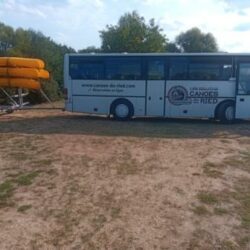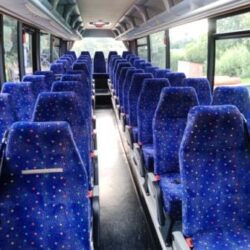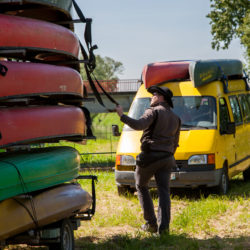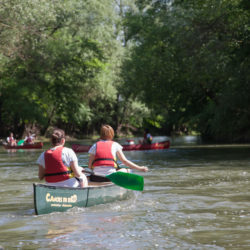Transport
Understand how transport is carried out at the Canoës du Ried

Modes of transportation
All our canoe services (with one exception: see Groups FAQ ) are carried out in so-called complete logistics.
The complete transport logistics corresponds to the fact that we transport all the participants and the rented equipment.
With a view to optimizing logistics but also saving time, our formulas being defined according to precise timetables, this mode of transport allows us to respect our “departure timing” (see the “More details” tab in the package and rates ).
Our customers therefore have a meeting place (our base) at a defined time, they park their vehicle there in a private and secure car park, then until the end of their canoeing activity, their vehicle will not move. All transportation is taken care of.
Transport capacities
Adapt capacity to crowds
Our fleet consists of:
- 4 9-seater minibuses, now mainly used for transporting equipment
- A small 19-seater coach assigned to the vast majority of our low-traffic and mid-season departures
- A 37-seater coach allowing transport in less accessible areas, being shorter compared to the 43-seater coach
- A 43-seater coach which is the main high season vehicle. It allows the equipment to leave before transporting people for preparation and saving time.
Our transport capacity is therefore high , but that does not mean that we want to put as many people as possible on the river. The normal operation of high attendance corresponds to 43 people per departure (about 20 canoes per departure), which we can increase on an event basis for a group that we limit to 60 sailors (excluding non-navigating minors 7-11 years old, see FAQ ).


Upstream Formulas
Our usual operation: an upstream departure:
- The appointment of our customers is always at our base in Sélestat ( See on Gmaps )
- Our base allows you to park your vehicles in a private and secure car park (access reserved for our customers)
- A formula upstream, the meeting corresponds to the arrival of the canoe course , once the registration, the equipment, the briefings carried out (course and maneuver), our Shuttle will take you to the starting point
- All the teams of the same formula have an appointment at the same time (except late hours for large groups), all the teams of the same formula have an appointment at our base
- Once deposited upstream, the teams will join the arrival by canoe according to the respect of the imperative time of the end.
- Conclusion: respecting appointment times is imperative . We will not delay a departure of other participants for latecomers, the departure will follow its course in their absence
- A classic departure timing will be: From the meeting time, 10 to 15 minutes are devoted to “Welcome, equipment, collection, preparation of the personal belongings of the teams”, then 10 to 15 minutes devoted to the “briefing”, then “installation in the shuttle and departure from it to the starting point” (on average 10, 15 or 20 minutes journey). At the starting point: launch and navigation in autonomy.
Minimize the time spent on the logistics of a departure by preparing it
- Arrive in attire for the activity
- Have prepared your “package” for the activity
- Centralize the payment of the service in order to limit the registration time.
- Have defined the “orientation manager(s)” in charge of orientation on the course and keep their mobile phone by securing it in a pocket in order to limit registration time.
- Have already assembled the teams. Who sails with whom?
- If the reservation is made by a participant of a group, send the information to the others before D-Day so that they can also prepare.
- Have read the documents and information provided.


 DE
DE EN
EN FR
FR